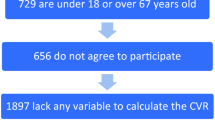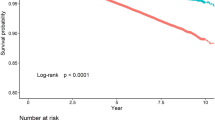Abstract
OBJECTIVE: To determine whether specific risk factors for obesity were more evident in young, normal-weight African-American (AA) compared to Caucasian-American (CA) women.
DESIGN: Cross-sectional age-matched study.
SUBJECTS: Young, nonobese, sedentary AA (n=13, 22.5 y of age, 23.6% body fat) and CA women (n=11, 21.5 y of age, 24.0% body fat).
MEASUREMENTS: Aerobic physical fitness (peak VO2), resting metabolic rate (RMR), resting and submaximal exercise fat oxidation rates, total daily energy expenditure (TDEE) by the doubly-labeled water method, physical activity energy expenditure (PAEE), skeletal muscle glycolytic (phosphofructokinase activity (PFK)) and β-oxidative (β-hydroxy-acyl CoA dehydrogenase (β-HADH)) activity, and insulin sensitivity estimated by the insulin-augmented frequently sampled intravenous glucose tolerance test.
RESULTS: The AA and CA subjects were similar in age, body mass index and body composition, but the AA women exhibited lower peak VO2. There were no group differences in RMR adjusted for body composition, or in the rates of submaximal exercise energy expenditure or fat oxidation, and no difference in skeletal muscle β-HADH or PFK activity. The AA women exhibited lower insulin sensitivity and greater acute insulin response to glucose. The mean TDEE for the AA women was only 74% that of the CA women, primarily due to a lower physical activity energy expenditure (AA group: x PAEE=1246±438 kJ/day; CA group: x=3310±466 kJ/day.
CONCLUSION: These data indicate that PAEE and its correlates of peak aerobic capacity and insulin sensitivity are lower in young, nonobese AA women compared to their CA counterparts.
This is a preview of subscription content, access via your institution
Access options
Subscribe to this journal
Receive 12 print issues and online access
$259.00 per year
only $21.58 per issue
Buy this article
- Purchase on Springer Link
- Instant access to full article PDF
Prices may be subject to local taxes which are calculated during checkout


Similar content being viewed by others
References
Kumanyika SK . Obesity in minority populations: an epidemiological assessment Obes Res 1994 2: 66–182.
Schoeller DA, Kushner RF . Increased rates of obesity among African Americans confirmed, but the question of why remains unanswered Ethnicity Health 1996 1: 313–315.
Ravussin E, Lillioja S, Knowler WC, Christin L, Freymond D, Abbott WG, Boyce V, Howard BV, Bogardus C . Reduced rate of energy expenditure as a risk factor for body weight gain New Engl J Med 1988 318: 467–482.
Zurlo F, Ferraro R, Fontvieille AM, Rising R, Bogardus C, Ravussin E . Spontaneous physical activity and obesity: cross-sectional and longitudinal studies in Pima Indians Am J Physiol 1992 263: E296–300.
Zurlo F, Lillioja S, Esposito-Del Puente A, Nyomba BL, Raz I, Saad MF, Swinburn BA, Knowler WC, Bogardus C, Ravussin E . Low ratio of fat to carbohydrate oxidation as a predictor of weight gain: study of 24-h RQ Am J Physiol 1991 259: E650–657.
Foster GD, Wadden TA, Vogt RA . Resting energy expenditure in obese African-American and Caucasian women Obes Res 1997 5: 1–8.
Albu J, Shur M, Curi M, Murphy L, Heymsfield SB, Pi-Sunyer XF . Resting metabolic rate in obese, premenopausal black women Am J Clin Nutr 1997 66: 531–538.
Jacicik JM, Wing RR . Differences in resting energy expenditure in African-American vs Caucasian overweight females Int J Obes Relat Metab Disord 1998 22: 236–242.
Forman JN, Miller WC, Szymanski LM, Fernhall B . Differences in resting metabolic rates of inactive obese African-American and Caucasian women Int J Obes Relat Metab Disord 1998 22: 215–221.
Weyer C, Snitker S, Bogardus C, Ravussin E . Energy metabolism in African Americans: potential risk factors for obesity Am J Clin Nutr 1999 70: 13–20.
Ainsworth BE, Berry CB, Schnyder, VN, Vickers SR . Leisure-time physical activity and aerobic fitness in African-American adults J Adolesc Health 1992 13: 606–611.
Crespo CJ, Keteyian SJ, Heath GW, Sempos CT . Leisure-time physical activity among US adults Arch Intern Med 1996 156: 93–98.
Wing RR, Kuller LH, Bunker C, Matthews K, Caggiula A, Meihlane E, Kelsey S . Obesity, obesity-related behaviors and coronary heart disease risk factors in African-American and Caucasian premenopausal women Int J Obes 1989 13: 511–519.
Washburn RA, Kline G, Lackland D, Wheeler FC . Leisure time physical activity: are there African-American/Caucasian differences Prev Med 1992 21: 127–135.
Melby, CL, Goldflies DG, Hyner GC . Blood pressure and anthropometric differences in regularly exercising and nonexercising black adults Clin Exper Hypert 1991 13: 1233–1248.
Carpenter WH, Fonong T, Toth MJ, Ades PA, Calles-Escandon J, Walston JD, Poehlman ET . Total daily energy expenditure in free-living older African-Americans and Caucasians Am J Physiol 1998 274: E96–101.
Kushner RF, Racette SB, Neil K, Schoeller DA . Measurement of physical activity among African-American and Caucasian obese women Obes Res 1995 3: 261s–265s.
Siedell JC, Muller DC, Sorkin JD, Andres R . Fasting respiratory exchange ratio and resting metabolic rate as predictors of weight gain: the Baltimore Longitudinal Study on Aging Int J Obes Relat Metab Disord 1992 16: 667–674.
Astrup A, Buemann B, Christensen NJ, Toubro S . Failure to increase lipid oxidation in response to increasing dietary fat content in formerly obese women Am J Physiol 1994 266: E592–599.
Chitwood LF, Brown SP, Lundy MJ, Dupper MA . Metabolic propensity toward obesity in black vs white females: responses during rest, exercise, and recovery Int J Obes Relat Metab Disord 1996 20: 455–462.
Swinburn BA, Nyomba, BL Saad MF, Zurlo F, Raz I, Knowler WC, Lillioja S, Bogardus C, Ravussin E . Insulin resistance associated with lower rates of weight gain in Pima Indians J Clin Invest 1991 88: 168–173.
Haffner SM, D'Agostino R, Saad MF, Rewers M, Mykkanen L, Selby J, Howard G, Savage PJ, Hamman RF, Wagenknecht LE . Increased insulin resistance and insulin secretion in nondiabetic African-Americans and Hispanics compared with non-Hispanic whites. The Insulin Resistance Atherosclerosis Study Diabetes 1996 45: 742–748.
Haffner SM . Epidemiology of type 2 diabetes: risk factors Diabetes Care 1998 21S3: C3–6.
Ama PFM, Simoneau JA, Boulay MR, Serresse O, Theriault G, Bouchard C . Skeletal muscle characteristics in sedentary black and Caucasian males J Appl Physiol 1986 61: 1758–1761.
Duey WJ, Bassett DR, Torok DJ, Howley ET, Bond V, Mancuso P, Trudell R . Skeletal muscle fibre type and capillary density in college-aged blacks and whites Ann Hum Biol 1997 24: 323–331.
Siri WE . The gross composition of the body Adv Biol Med Phys 1956 4: 239–280.
Wilmore JH . A simplified method for determination of residual lung volume J Appl Physiol 1969 27: 96–100.
deWeir JB . New methods for calculating metabolic rate with special reference to protein metabolism J Physiol 1949 109: 1–9.
Gayles EC, Pagliassotti MJ, Prach PA, Koppenhafer TA, Hill JO . Contribution of energy intake and tissue enzymatic profile to body weight gain high-fat-fed rats Am J Physiol 1997 272: R188–194.
Bergman RN, Finegood DT, Ader M . Assessment of insulin sensitivity in vivo Endocr Rev 1985 6: 45–86.
Goran MI, Poehlman ET . Endurance training does not enhance total energy expenditure in healthy elderly persons Am J Physiol 1992 263: E950–957.
Levine JA, Eberhardt NL, Jensen MD . Role of nonexercise activity thermogenesis in resistance to fat gain in humans Science 1999 283: 212–214.
Jiang X, Srinivasan SR, Radhakrishnamurthy B, Dalfares ER, Berenson GS . Racial (black–white) differences in insulin secretion and clearance in adolescents: the Bogalusa Heart Study Pediatrics 1996 97: 357–360.
Svec F, Nastasi K, Hilton C, Bao W, Srinivasan SR, Berenson G . Black-white contrasts in insulin levels during pubertal development Diabetes 1992 41: 313–317.
Solomon SJ, Kurzer MS, Calloway DH . Menstrual cycle and basal metabolic rate in women Am J Clin Nutr 1982 36: 611–616.
Acknowledgements
This work was supported by the National Institutes of Health (P30 DK-48520-01) and General Clinical Research Center Grant (RR-00051), and the Colorado Agricultural Experiment Station (Project 616). We gratefully acknowledge the assistance of Dr James O Hill, Dr Michael Pagliassotti, Teresa Sharp, Curtis Jatkauskas, and the Nursing Staff of the General Clinical Nutrition Research Center from the University of Colorado Health Sciences Center, and Harry Vaughn and Dr Christine Lindquist from the University of Alabama-Birmingham. Additionally we would like to thank the Office of Black Student Services at Colorado State University for help in recruiting study participants, and we are especially greatful to the women who kindly volunteered to participate in this study.
Author information
Authors and Affiliations
Corresponding author
Rights and permissions
About this article
Cite this article
Melby, C., Ho, R., Jeckel, K. et al. Comparison of risk factors for obesity in young, nonobese African-American and Caucasian women. Int J Obes 24, 1514–1522 (2000). https://doi.org/10.1038/sj.ijo.0801413
Received:
Revised:
Accepted:
Published:
Issue Date:
DOI: https://doi.org/10.1038/sj.ijo.0801413
Keywords
This article is cited by
-
HIF1A P582S gene association with endurance training responses in young women
European Journal of Applied Physiology (2011)
-
Physical activity energy expenditure has not declined since the 1980s and matches energy expenditures of wild mammals
International Journal of Obesity (2008)
-
Skeletal Muscle Fat Oxidation Is Increased in African-American and White Women after 10 days of Endurance Exercise Training*
Obesity (2006)



